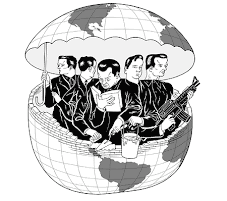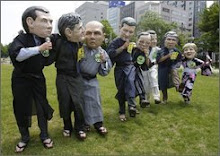New York Times, October 10, 2008
By VIKAS BAJAJ
Until 3 p.m. on Thursday, it seemed as if the stock market might escape another dark day.
Then the selling hit — and hit and hit again, mimicking trading on Tuesday and Wednesday. What had been a moderately down day ended in a rout, with the Dow Jones industrial average closing down 679 points, or 7.3 percent, leaving it below 9,000 for the first time in five years.
In the busiest day in New York Stock Exchange history, panicky investors dumped stocks en masse. Almost no corner of the market was spared, with 1,754 stocks falling and just 87 rising on the Big Board.
Despite unprecedented steps by policy makers around the world to defuse the financial crisis, fear is spreading that a deep global recession is at hand. The credit markets, the heart of the financial system, remained in near paralysis.
“There is a downward spiral of fear,” said Richard Sparks, senior equities analyst at Schaeffer’s Investment Research.
The plunge came in a stomach-churning 90 minutes. The Dow was down just 140 points at 2:30 p.m., and 200 points at 3. But then, wave after wave of selling began to roll through the market. By 3:20, the index was down 380 points. Ten minutes later, it was down 390 points. By 3:45, it was down 660. After staging a brief rally, it fell again.
In the last six trading days — starting last Thursday — the Dow has plummeted 2,251.8 points, or 20.8 percent, a decline big enough, on its own, to mark the start of a bear market. It also is similar to the drop in the Dow on Black Monday, Oct. 19, 1987, when it fell 22.6 percent.
Big oil companies like Exxon Mobil and Chevron pulled the Dow lower, falling by roughly 12 percent each.
General Motors, the embattled automaker, fell $2.15, to $4.76. As a group, financial shares were hit the hardest, falling nearly 12 percent.
At current prices, analysts say, the market is suggesting that investors fear the kind of severe and long recession the country has not had since at least the early 1970s.
Reflecting concerns about the economy, crude oil prices fell 2.7 percent, to $86.59 a barrel. OPEC, the oil-producing cartel, on Thursday called an emergency meeting for Nov. 18 to consider cutting an output in an attempt to arrest the 41 percent drop in oil prices in the last three months.
Asian markets also reacted strongly to the turmoil. In Japan, the Nikkei 225 index was down 10 percent on Friday morning, after having plunged 9 percent on Wednesday. The Hang Seng index in Hong Kong fell 7 percent and the market in Singapore was down 6.8 percent.
What has prompted the late-day sell-offs recently is a subject of intense debate and conjecture, even among market professionals, who also have been unnerved by the free fall of the week.
Some attribute it to mutual funds’ waiting until midafternoon to execute sell orders from a growing number of investors who are cutting their exposure or bailing out of the market altogether. Others say that hedge funds, which have leveraged returns in recent years by using borrowed money, are having to sell holdings to raise collateral against their borrowings.
Still others say computerized trading, which has grown significantly in recent years, often kicks in later in the day, when certain thresholds are breached.
But whatever the reasons for the late-day plunges, what is driving the market down is a lack of confidence by investors, who are skeptical that the many measures taken by the government to rescue the financial system will work. Moreover, they worry that the government’s trotting out a new initiative every day or two is a sign that maybe the situation is worse than many thought.
Some who have held on until now are starting to sell. Since the start of the year, investors have removed more than $81 billion from stock mutual funds, with nearly 40 percent of that coming in the last six weeks, according to AMG Data Services.
Trevor Callan, a financial planner in La Jolla, Calif., said he has been bombarded by calls since Wednesday from nearly every one of his clients.
“The bottom line here is we’re witnessing complete panic,” Mr. Callan said. “There are certainly periods of time where rationality is thrown out the window, and this is one of them.”
The staggering decline in stocks has some investors questioning when the markets will stabilize. In fact, some pros believe that stocks bottom when many average investors pull out on a day of heavy selling — also known as capitulation.
Michael Cerenzie, a film producer, said he had been selling out of his million-dollar position in banking stocks and was looking to invest in companies specializing in natural gas and energy.
“This isn’t going to come back,” he said of the recent stock market losses. “This is going to be a long one. We are not going to see returns like we did in the past.”
Individuals are not the only ones bailing out. Market professionals are also selling, often even when they do not want to.
Many hedge funds have been forced to sell stocks and bonds this week because their lenders, big banks like Goldman Sachs and Morgan Stanley, demanded that they put up more capital against their positions and pay down margin loans.
Those demands are determined by a variety of factors like rising volatility and falling prices — all of which have been true in the last few days. In addition, because the banks are paying more to borrow money themselves, they are charging hedge funds more for loans, several bankers said.
Hedge funds, which cater to pension plans, endowments and wealthy individuals, have also had to sell to meet redemption requests from their clients.
With hedge funds selling and banks, including several in Iceland, in trouble, the market is experiencing “really big liquidations,” said Kingman Penniman, president of KDP Advisors, a bond research firm.
Those sales have driven down prices to such an extent that bank loans, which are considered much safer than bonds, are trading at levels implying that nearly a third of them will go into default. As of the end of September, defaults have climbed to just 3.3 percent.
“We are flushing out the system,” Mr. Penniman said. Referring to bankers and investors, he said, “They have decided that there is little they can do. We wanted to de-lever the whole financial system, and the hope was that it would be done in a orderly fashion. And they have given up all hope of that.”
Jane Caron, chief economic strategist at Dwight Asset Management, a bond trading firm, said professional investors were increasingly reluctant to buy because the computer models they used in the past had failed them. Like many everyday investors, the professionals fear that even though prices have fallen significantly, they could sustain further losses.
“Nobody is willing to transact,” Ms. Caron said, “and behind that, there are a lot of concerns about solvency.”
What happened on Thursday partly reflects the unintended consequences of regulators’ attempts to bolster stock prices several weeks ago, when the Securities and Exchange Commission temporarily banned short-selling in nearly 1,000 stocks.
That restriction was lifted at midnight on Wednesday. Short-selling is a practice in which investors sell shares they do not own in the hopes of buying them back later at a lower price. Many money managers use it to hedge their investments against future losses.
Analysts said those investors were probably forced to sell shares short on Thursday to protect themselves.
Those explanations not withstanding, many money managers said they had not seen stocks beaten up quite this much in a long time. The Standard & Poor’s 500-stock index is now down nearly 42 percent from its peak a year to the day from Thursday.
That decline makes this the third-worst bear market since World War II and the sixth-worst since 1929, according to Standard & Poor’s Equity Research. It would also qualify as one of the speediest declines in stock prices in history. The S.& P. 500 closed down 7.6 percent, to 909.92. The Dow closed at 8,579.19. Nearly 8.3 million stocks were traded on the New York exchange.
John Dorfman, manager of the Dorfman Value Fund, a mutual fund based in Boston, said he thought a bottom was near. While the economy is most likely in a recession, he said, he does not expect a depression. “A crisis always feels bottomless, and it usually isn’t,” he said.
Robert M. Solow, who won the Nobel Prize in 1987 for his work on economic growth, said that “potential for instability was always there,” but he was caught by surprise at the magnitude of the problems in the economy and financial system.
“I’m as puzzled as anyone else,” he said. “I don’t have any particular wisdom to sell.”
The benchmark 10-year Treasury bill fell 1 9/32, to 101 23/32, and the yield, which moves in the opposite direction from the price, was at 3.79 percent, up from 3.64 percent late Wednesday.
Following are the results of Thursday’s Treasury auction of the 7-year note, 10-year note and 97-day cash management bills:
Reporting was contributed by Laura M. Holson, Louise Story, Graham Bowley and Diana B. Henriques.
Copyright 2008 The New York Times Company
Subscribe to:
Post Comments (Atom)
Rafael V. Mariano, chairperson of the Peasant Movement of the Philippines, 2000
Food has long been a political tool in US foreign policy. Twenty-five years ago USDA Secretary Earl Butz told the 1974 World Food Conference in Rome that food was a weapon, calling it 'one of the principal tools in our negotiating kit.' As far back as 1957 US Vice-President Hubert Humphrey told a US audience, "If you are looking for a way to get people to lean on you and to be dependent on you in terms of their cooperation with you, it seems to me that food dependence would be terrific."



No comments:
Post a Comment